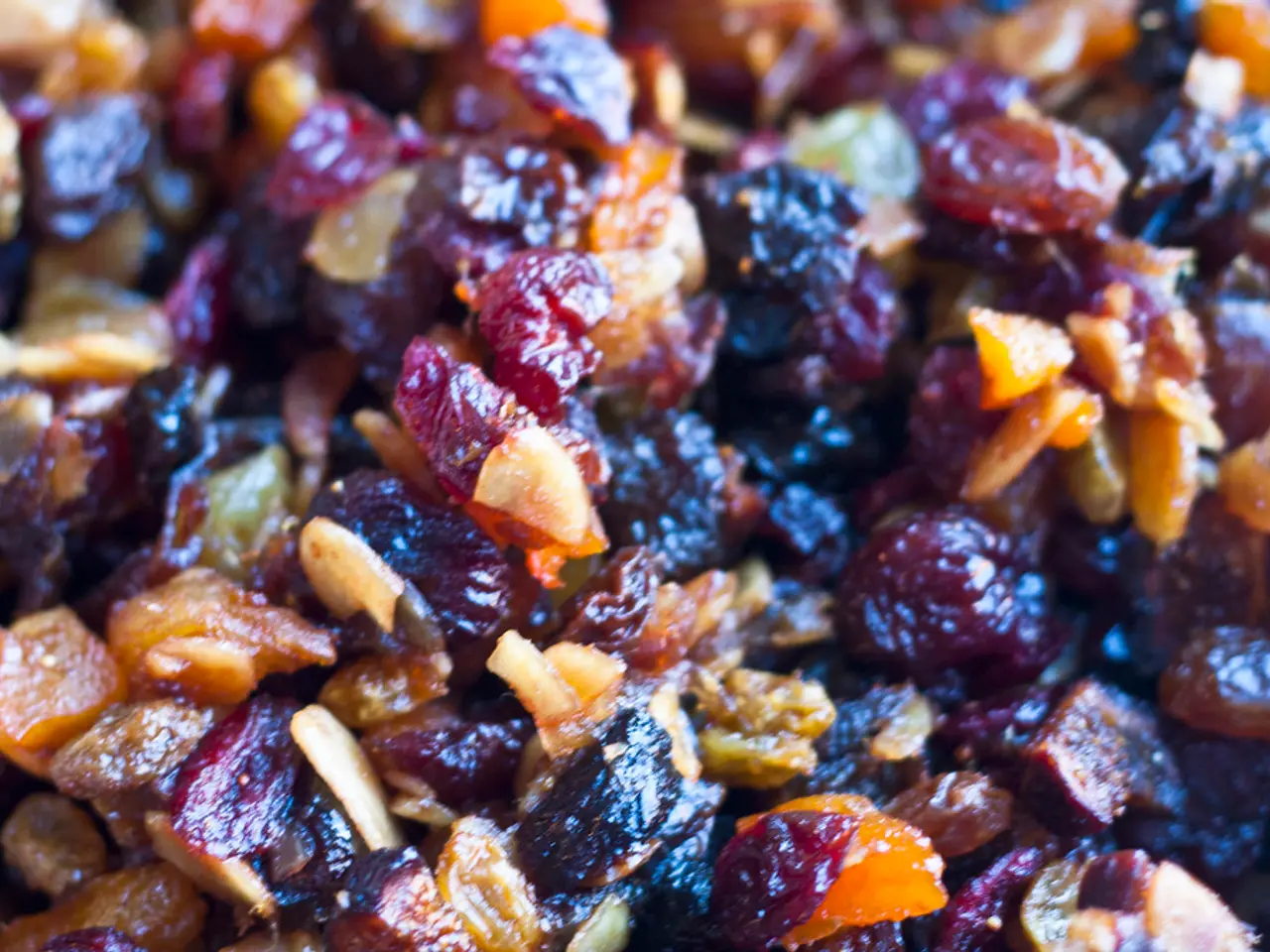Enhance Your Dietary Fiber Intake for Better Health
=====================================================
Incorporating more fiber into your diet can bring numerous health benefits, including supporting weight loss, blood sugar regulation, heart health, and regular bowel movements. The recommended daily fiber intake varies based on age, sex, and other factors, but most adults should aim for at least 25 grams of fiber per day [1][2].
Fiber, a type of carbohydrate found in plant-based foods that cannot be fully digested by the body, plays a crucial role in maintaining a healthy digestive system. There are two main types of fiber: soluble fiber and insoluble fiber [1].
Soluble fiber dissolves in water and forms a gel-like substance in the colon, aiding in weight management and regular digestion. Good sources of soluble fiber include oats, nuts, seeds, beans, legumes, and certain fruits and vegetables [2][4]. For weight loss and blood sugar control, prioritize soluble fiber, which forms a gel and slows digestion.
On the other hand, insoluble fiber does not dissolve in water, adds bulk to the stool, and acts as a brush in the colon to help keep the digestive system regular. Sources of insoluble fiber include the skins and peels of fruits and vegetables, legumes, and whole grains [1][2].
To increase your daily fiber intake, start by adding more whole fruits and vegetables (with peels on), whole grains like oats, barley, and quinoa, and legumes such as lentils and beans to your meals [1][3][4]. Incorporate nuts and seeds like chia or flax seeds into smoothies or baked goods for extra fiber [3]. Choose foods close to their natural form, as processing often removes fiber (e.g., whole apples vs. applesauce or juice) [1].
For practical steps, consider starting the day with oatmeal or bran cereal [1][3], eating at least 4-5 servings of fruits and vegetables per day, preferably with skins [1], replacing refined grains with whole grain breads and cereals [1][2], cooking with lentils and a variety of beans to boost fiber and protein [3][4], and adding seeds and nuts to snacks or meals [3].
Increasing fiber consumption can support weight loss by promoting satiety and providing fewer calories for the same volume of food. Additionally, fiber can help lower LDL cholesterol levels (the "bad cholesterol") [2]. Fiber also supports a healthy microbiome by acting as a prebiotic, providing food for the good bacteria in the gut [1].
However, overeating fiber can leave you feeling bloated, gassy, and uncomfortable. Gradually increase fiber intake by 10-15 grams per day to the recommended target of about 30-35 grams daily to avoid digestive discomfort [3].
In conclusion, incorporating a balanced mix of soluble and insoluble fiber sources into your diet can bring significant health benefits. Aim for the daily recommended amount of fiber and slowly work your way up to it to get your body used to the extra fiber. The American Heart Association and the American Diabetes Association recommend that adults get 25 to 38 grams of fiber daily [1][2].
[1] Mayo Clinic. (2021). Fiber: Essential for a healthy diet. https://www.mayoclinic.org/healthy-lifestyle/nutrition-and-healthy-eating/in-depth/fiber/art-20043967
[2] American Heart Association. (2021). Fiber: What is it and why is it important? https://www.heart.org/en/healthy-living/healthy-eating/eat-smart/nutrition-basics/fiber-what-is-it-and-why-is-it-important
[3] Harvard T.H. Chan School of Public Health. (2021). Fiber. https://www.hsph.harvard.edu/nutritionsource/carbohydrates/fiber/
[4] Academy of Nutrition and Dietetics. (2021). Dietary Fiber. https://www.eatright.org/food/nutrition/dietary-guidelines-and-your-health/dietary-fiber
- To enhance general news about wellness, acknowledging the role of character in maintaining one's health, it's essential to prioritize a well-rounded diet that includes nutrient-rich foods and fiber.
- For science enthusiasts seeking news on health and wellness, exploring the impact of fiber-rich diets on fitness and exercise could yield insightful findings related to weight management and heart health.
- In the realm of style and beauty, incorporating healthy habits such as consuming fiber-rich foods and following a regular exercise routine can contribute to an overall picture of well-being and vitality.
- While traveling, incorporating local sources of fiber like fruits, vegetables, and whole grains into your diet can help ensure continued support for regular digestion and improved health, in addition to experiencing the regional culinary delights.
- As we delve deeper into understanding the science of nutrition, it becomes evident that etiquette plays a role in health maintenance. For instance, mindfully chewing food and avoiding distractions during meals can aid in better digestion, as good manners can boost the overall quality of our dining experiences.




